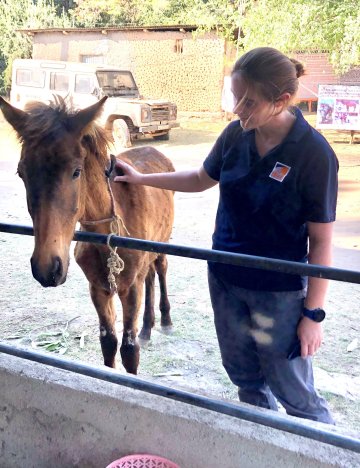A global team: Animal health through the eyes of a vet
Dr Izzy and Brooke vets in Ethiopia.
The World Organisation for Animal Health’s General Assembly is this week (25-29 May 2025), which prioritises improving animal health worldwide.
Dr Izzy Hocking shares her dedication to making a difference to the health of working horses, donkeys and mules, through her role as a Brooke vet.
What is a typical day as a vet like for you at Brooke?
A typical day for me is spent at my desk, as part of a global team with Brooke vets all over the world.
It took some getting used to after my previous job working in a busy veterinary hospital!
I visit Brooke’s country programmes around six times a year, to deliver training workshops to our teams. My day usually involves meetings and time spent creating resources for Brooke field staff, including training workshops.
What are the most common health issues or injuries you encounter in working animals?
The most common problems I see when travelling to Brooke’s countries of operation are wounds and lameness.
In terms of treating these problems, the most important things are always pain relief and rest. They aren’t always easy to provide where Brooke works though, as pain relief medicines suitable for horses, donkeys and mules are not always readily available.
Working animals may be their owners’ only source of income and this can mean it is harder for them to give their animals a decent amount of rest.
Dr Izzy runs a training session with vets in Malawi.
Wounds are often associated with harnessing problems, and our Global Harnessing Programme is working to improve the standard of harnessing and reduce the risk of harness related wounds.
Similarly, many lameness cases are associated with hoof problems, and our Global Farriery Project works to improve hoof care and farriery to help prevent these problems.

How do you approach handling when working with animals, especially those who are stressed or in pain?
Sadly, almost all animals will be stressed when seeing a vet, often because they remember feeling poorly last time they came to see us.
It is our job to read their body language for signs of worry.
Whenever an animal is presenting with a “challenging” behaviour that is hindering vets’ ability to examine or help them, it’s always so important to take a step back to try and understand why they might be showing that behaviour.
The more proactive we are at reading signs of stress, the more positive the interaction will be for everyone involved!
Animals can’t tell us what’s wrong, and often their behaviour is the only way of them communicating that they need something.
Is it that they’re tired, hot, hungry or thirsty? Are we in too busy an area, with lots of loud noises that could be frightening them?
Do they have an equine friend that normally keeps them company? Most importantly for us as vets, could it be that they’re in pain?
Once we’ve worked out why they might be behaving that way, we can address those things and often that is enough to be able to get on with our veterinary work.
Brooke vets at Hawassa University clinical skills lab in Ethiopia.
Sometimes, behavioural issues in animals can be caused by a much more deep-rooted trauma, that requires more specialised rehabilitation to overcome.
That’s where Brooke's Compassionate Handing Framework can come in and support vets and owners to work with their animals.
What’s one of the most rewarding or memorable experiences you’ve had treating a working animal?
As a Brooke UK vet, I don’t treat animals when I travel to our country programmes, but we do train our colleagues which can involve mentoring them through clinical cases.
One of my most memorable experiences was when I travelled to Ethiopia in 2024, to train Brooke vets in how to use Meloxicam, a pain relief medicine recently available there.
It was great to be able to show the value of using pain relief medicine - both to the vets and owner, who could see the dramatic difference it made.
We trained in the government veterinary clinic, where we saw a horse with a very painful eye. His eye was clamped shut, and he would not let us anywhere near it as he was in so much pain.
Luckily, we could give him an injection of the new medicine. Watching pain relief take effect in real time was amazing.
Dr Izzy with a horse in Senegal.
I am very lucky to work with such an amazing team of vets around the world!
How do you collaborate with other vets and professionals to ensure the best care for animals?
I am lucky to be part of a truly global team at Brooke, meaning I work with both vets and other professionals all around the world every day.
Often, when one team of vets at Brooke is facing a challenge, another team have faced a similar issue and can offer learning and insights from their experiences.
